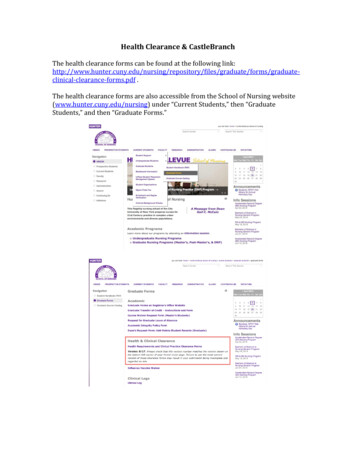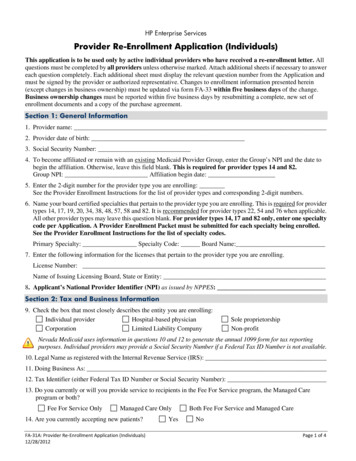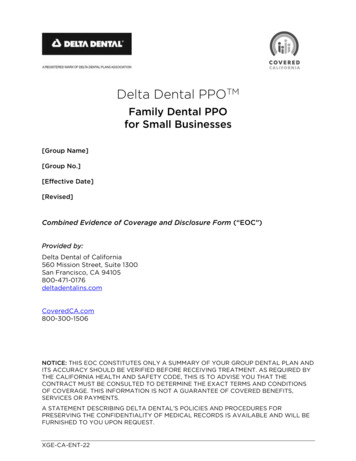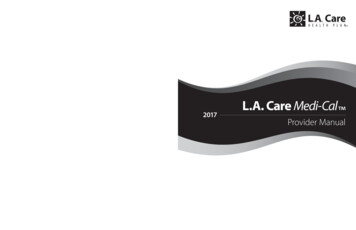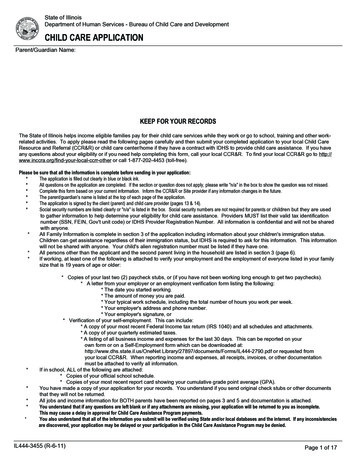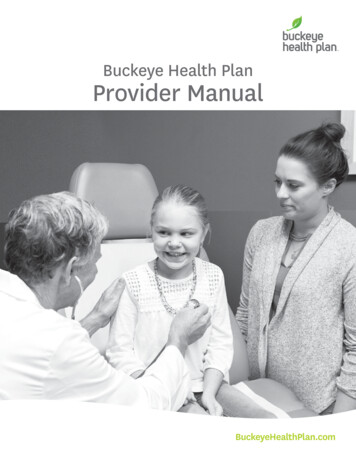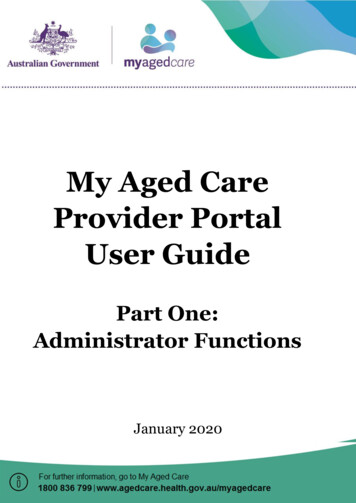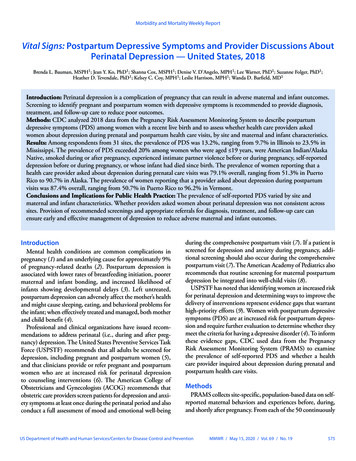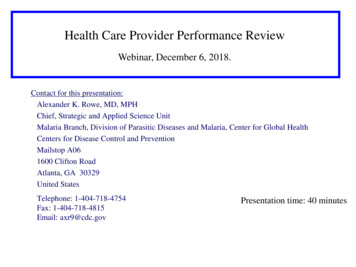
Transcription
Health Care Provider Performance ReviewWebinar, December 6, 2018.Contact for this presentation:Alexander K. Rowe, MD, MPHChief, Strategic and Applied Science UnitMalaria Branch, Division of Parasitic Diseases and Malaria, Center for Global HealthCenters for Disease Control and PreventionMailstop A061600 Clifton RoadAtlanta, GA 30329United StatesTelephone: 1-404-718-4754Fax: 1-404-718-4815Email: axr9@cdc.govPresentation time: 40 minutes
Effectiveness of strategies toimprove health care providerperformance in low- andmiddle-income countries:a systematic reviewAlexander K. Rowe, MD, MPHMalaria Branch,Division of Parasitic Disease and Malaria, Center for Global Health,Centers for Disease Control and PreventionCenter for Global HealthMalaria Branch
Health Care Provider Performance ReviewCo-investigators Samantha Y. Rowe (Malaria Branch, CDC) David H. Peters (Johns HopkinsBloomberg School of Public Health) Kathleen A. Holloway (World HealthOrganization, International Instituteof Health Management Research,and University of Sussex) John Chalker (Management Sciences for Health) Dennis Ross-Degnan (Harvard Medical School)Dataabstractionteam
Acknowledgments Sushama AcharyaCharity AkpalaDinorah CallesTashana CartyNirali ChakrabortyHelen ChinAdrijana CorlukaDidi CrossBhavya DoshiOnnalee GomezMeg GriffithKaren HermanAtsumi HiroseSimon Lewin Qing LiConnie LiuEarl LongJason McKnightEliza McLeodHuseyin NaciJan Odgaard-JensenDawn OsterholtAndy OxmanMagdalena PaczkowskiGabriel Ponce-de-LéonNancy PulsipherAtiq RahmanMonica Shah Banafsheh SiadatSanja StanojevicLaura SteinhardtSavitha SubramanianMegan ThompsonAnil ThotaRyan WiegandJeff WillisKindra WillisShannon WoodKaren WosjeAbera WouhibAlicia WrightChunying Xie Special thanks to investigators who responded to queries Funding: Bill and Melinda Gates Foundation, CDC, World Bank
Background Health care providers (HCPs) play essentialroles in delivering health care In low- and middle-income countries (LMICs),however, HCP performance often inadequate Estimated 5 million deaths per year due to poorquality among people using care Improving HCP performance is important forprograms and patients they serve, required forSustainable Development Goal of achievinguniversal health coverage
Background Many strategies exist to improve performance, andsummary of evidence would be useful Existing reviews have limitations, especially that theytypically focus on only a narrow range of strategies Decision-makers, however, ask broader question:What are most effective ways to improve performance? To answer this broader question, one needs to comparemultiple strategies Health Care Provider Performance Review (HCPPR):systematic review designed to help fill this gap bycomparing all strategies
METHODS
Inclusion criteria Any quantitative study of effectiveness of any strategy toimprove HCP performance in LMIC, on any health topic,in any language, published or not HCP. Any facility- or community-based health worker,pharmacists, shopkeepers who sell drugs, private sector Literature search Included studies from 1960s to May 2016 52 electronic databases of published studies (eg, MEDLINE) 58 document inventories & websites for unpublished studies
Eligible study designs Pre-intervention vs. post-intervention study withcomparison ( /- randomization) Post-intervention only study with randomized controls Interrupted time series ( 3 data points before and afterintervention)
Defining strategy groups Determined which individual strategy components wereused (e.g., training supervision 2 components) 207 components identified Created 12 component categories (e.g., training,supervision, incentives, etc.) Defined strategy as unique combination of 12component categories, for example––––Training onlyTraining supervisionTraining supervision incentivesEtc.
Defining strategies: 12 component categories1) Community support: E.g., community health education2) Patient support: E.g., patient education3) Strengthening infrastructure: E.g., provision of drugs4) HCP-directed financial incentives5) Health system financing and other incentives. E.g., insurance6) Regulation and governance: E.g., accreditation7) Group problem solving: E.g., collaborative improvement8) Supervision: E.g., improving routine supervision, audit with feedback9) Other management techniques: E.g., HCP self-assessment10) Training11) Printed information or job aids for HCPs12) Information & communication technology (ICT) for HCPs:E.g., reminders sent to HCP phone
Analysis of effect sizes Effect size in terms of %-point change Example formula for outcomes expressed as %:Effect size (FU – BL)intervention – (FU – BL)control% of patients correctly treated604020Intervention25%20% Control50%Change (50% – 25%) 25 %-points30%Change (30% – 20%) 10 %-points0BaselineFollow-upEffect size 25 – 10 15 %-pointsFor every 100 patients, 15 treated correctly
Analysis Primary method– Only include strategy vs. control comparisons(no head-to-head studies)– If study had 1 primary outcome (thus 1 effect size),study represented by median of effect sizes (MES)– Compare MES distributions of various strategies:weighted medians, IQRs (weight 1 ln[no. of HCPs or HFs])– To reduce bias, effect sizes of outcomes expressed aspercentage from studies of professional HCPs wereadjusted for baseline performance, public HF only, & Asia
RESULTS
Literature search 216,477 citations screened 2269 reports included in review (all outcomes) For HCP practice outcomes (focus of presentation,e.g., % of patients correctly diagnosed or treated)– Included 670 reports from 337 studies– Identified 118 strategies Wide range of contexts– Urban and rural– Public & private health facilities, community settings– Numerous health conditions
Study sites (337 studies with HCP practice outcomes) 64 countries 40% from low-income countriesEastern Mediterranean 7%Western Pacific 13%3% Europe42% AfricaAmericas 16%20% Southeast Asia
Overall risk of biasBased on guidance from Cochrane’s EPOC groupVery high:30%Low:16%Moderate:25%High:29%
120114Studies often short, relative to whatmost programs would considersustained effectNo. of studies1008072Two-thirds had follow-up times 10 months60402035381817406641Study follow-up time, in months11
Effectiveness of strategiesto improve HCP practices:Studies of professionalhealth workers(generally facility-based healthworkers, such as physicians,nurses, and midwives)Results of outcomes expressed as %(e.g., % of patients treated correctly)Top photo: TF Org. em-summary-recent-publications/. Accessed November 10, 2018.
General findings Mean baseline: 40% Among all 101 strategies, median improvement 12 %-pts(Typical scenario: 40% BL 12 %-pt improvement 52% F/U) Most strategies (80%) tested by only 1 or 2 studies-Generalizability extremely limited-Presentation focuses on strategies tested by at least 3 studies Effect sizes vary widely for most strategies- Ex. Train only, median effect: 10 %-pts (IQR: 6, 21; range: –20, 61)Thus, ¼ of effects: 6 %-pts, and ¼ of effects: 21 to 61 %-pts- Demonstrates difficulty in predicting strategy’s effect- Underscores importance of monitoring effect of any strategy
Effectiveness of strategies tested by 3 studiesMedian effectsize, %-pts Printed information or job aids for HCPs only1 ICT for HCPs as sole strategy (N 4 studies)1Information andcommunicationtechnology(mHealth)
Effectiveness of strategies tested by 3 studiesMedian effectsize, %-pts Printed information or job aids for HCPs only1 ICT for HCPs as sole strategy (N 4 studies)1- Broadened strategy definition (ICT /- otherstrategy components, N 28 studies)8Goal: analyze larger pool of studies with greater diversityof context and implementation approaches
Effectiveness of strategies tested by 3 studiesMedian effectsize, %-pts Printed information or job aids for HCPs only1 ICT for HCPs as sole strategy (N 4 studies)1- Broadened strategy definition (ICT /- otherstrategy components, N 28 studies)8 Training only10 Supervision only15 Training supervision18
Effectiveness of strategies tested by 3 studiesMedian effect size,%-pts (broadeneddefinition) Group problem solving onlyE.g., CQI or collaborative improvement28 (12)
Effectiveness of strategies tested by 3 studiesMedian effect size,%-pts (broadeneddefinition) Group problem solving only28 (12) Group problem solving training56 (16) Strengthened infrastructure supervision other mgmt techniques training33 (29)E.g., HCP group process/meetingsE.g., Provision of medicines
Effectiveness of strategies tested by 3 studiesMedian effect size,%-pts (broadeneddefinition) Group problem solving only28 (12) Group problem solving training56 (16) Strengthened infrastructure supervision other mgmt techniques training33 (29) Strengthened infrastructure supervision other mgmt techniques training financing58 (33)Are multi-faceted strategies more effective than simpler ones?
Effect size (percentage points)Are multi-faceted strategies more effectivethan simpler ones?Number of strategy components
Effect size (percentage points)Are multi-faceted strategies more effectivethan simpler ones?Number of strategy components
Strategies tested by 3 studies (“hot topics”)Median effect size,%-pts (broadeneddefinition) Financial incentives for HCPs only26 (7) Health system financing or otherincentives only (i.e., not financialincentives for HCPs)1 (14) Regulation/governance onlyNA (28)No eligible studies found ofregulation/governance as sole strategy
Context-specific analysisStratify effectiveness results:low versus moderate level ofresources (what works where?)
Low- vs. moderate-resource settingStrategy (with 3 All settingsLowModeratecomparisons perresource*resource**stratum and 10 %-pt (mediandifference betweenMES)(median MES) (median MES)strata)Group problemsolving only281240Supervision training181225* Non-hospital settings in low-income countries and rural-only settingsin middle-income countries** Hospitals in low-income countries and any urban & mixed urban/ruralsettings in middle-income countries
Low- vs. moderate-resource settingStrategy (with 3 All settingsLowModeratecomparisons perresource*resource**stratum and 10 %-pt (mediandifference betweenMES)(median MES) (median MES)strata)Group problemsolving only281240Supervision training181225Not all strategies have large stratum-specificdifferences for “low vs. moderate resource” factor,and some strategies have large stratum-specificdifferences for other contextual factors.
Factors associated withtraining effectiveness(Are some trainingapproaches more effectiveor more efficient?)
Factors associated with training effectiveness Interaction between training duration and complexityof training topic: additional days increase mean effectbut only for multiple health topicsEx: IntegratedManagement ofChildhood Illness(IMCI)Effect size (%-points)4030Multiple topics (p .01)All 6 days2010Single topic (p .04)001234567Days of training8910For single-topictraining, no benefit tohaving longer courses
Factors associated with training effectiveness Mean effect 6–11 %-pts higher if some or all training ison-site (compared with all off-site training) Time since training: effect of training wanes over time Interaction between supervision and time since training:supervision “protects” against waning effect of trainingEffect size (%-points)4030Supervision present(p 0.8)2010Nosupervision*00* p .000151015Months since training20Waningeffect
Effect of strategies toimprove performanceof lay or communityhealth workers (CHWs)Results of outcomesexpressed as percentage(e.g., % of patients treatedcorrectly)Top image. Malaria Consortium. -world-health-workers-week-2/. Accessed May 16, 2018Lower image. World Vision. laria-burundi-halfcountry-sick. Accessed May 16, 2018.
Improving lay or CHW performance 18 studies, most with high or very high risk of bias 14 strategies, most tested by 1 or 2 studies each For training only (N 4 studies), median effect 2 %-points For strategies that included community supportand training CHWs, effects ranged from 8 to 56%-points
Evidence-based guidanceon improving HCPperformance in LMICs
General guidance on improving HCP practices1) Effect of any strategy should be monitored so managerscan know how well it works. Monitoring data could beused to adapt strategies to local conditions and facilitatelearning, with aim of increasing effectiveness.2) General approach Initial strategy (based on research evidence andknowledge of local context)Monitor HCP practicesAddress gaps (which should be expected) by modifyingor abandoning strategy or layering on new oneContinue to monitor and modify as needed3) Decision-makers should not assume multi-facetedstrategies are more effective than simpler ones
Guidance for professional HCPs (i.e., not only CHWs)1) Printed information or job aids to HCPs as sole strategyis unlikely to change performance2) ICT typically has small-to-modest effects3) Training or supervision generally have moderate effects.May be more effective to combine training with otherstrategies, such as supervision or group problem solving. To increase effect of training on multiple health topics,duration at least 3 days might be beneficial, with additionaldays potentially increasing effectiveness For training on single health topics, short duration (1–2 days)seems as effective as longer duration (and less expensive)
Guidance for professional HCPs (i.e., not only CHWs)4) Group problem solving typically has moderate effects5) Multifaceted strategies of infrastructure, supervision,management techniques, and training ( /- financing), andstrategy of group problem solving training tend to havelarge effects6) Financial incentives for HCPs, & other finance/incentivestrategies typically have modest–moderate effects7) Effect of regulation/governance alone is unknown; it tendsto have large effects when combined with other components8) Programs might consider influence of context on strategyeffect. Some (e.g., group problem solving) might be moreeffective in moderate-resource areas.
Guidance for improving CHW performance1) Only training CHWs usually has small effects2) Strategies that include community support plus trainingfor CHWs might lead to large improvements, althoughevidence is limited
Limitations1) Limitations of studies: lack of detail on strategy andcontext, lack of standard methods, difficulty in assessingstudy precision and strength of implementation, high riskof bias, and short follow-up time2) With many statistical tests performed, results representhypothesis screening, not true hypothesis testing3) Overview analysis—i.e., intentionally designed toidentify broad patterns across all studies. Thus, resultsdo not reflect nuances, e.g., all countries combined.Future analyses will be more specific.
HCPPR website:www.hcpperformancereview.org
HCPPR website:www.hcpperformancereview.org
HCPPR website:www.hcpperformancereview.org
HCPPR website:www.hcpperformancereview.org1) Use menus to select studies2) Click on “Run analysis”
HCPPR website:www.hcpperformancereview.org1) Use menus to select studies2) Click on “Run analysis”
HCPPR website:www.hcpperformancereview.org
Conclusions1) Important performance problems exist, but there arestrategies to improve quality of care2) Research has some important limitations, but results stilluseful to inform decision-making3) Some strategies seem more effective than others(e.g., training group problem solving, some multi-facetedstrategies); consider using in appropriate context4) Might be ways to make training more effective and efficient5) Avoid ineffective strategies (e.g., only printed info)6) Important to monitor effectiveness for all strategies7) High-quality research needed (e.g., on CHWs)
Conclusions8) HCPPR is largest review of strategies to improveHCP performance in LMICs Programs, donors, and other development partnersconsider results when making decisions To help disseminate results and encourage morespecific analyses, the database is publicly availableon website
Visit our website:www.hcpperformancereview.orgLancet Global Health, October 2018(appendices: additional methods and results)
Thank you!Any questionsor comments?www.hcpperformancereview.orgFor more information please contact Centers for Disease Control and Prevention1600 Clifton Road NE, Atlanta, GA 30333Telephone: 1-800-CDC-INFO (232-4636)/TTY: 1-888-232-6348E-mail: cdcinfo@cdc.govWeb: http://www.cdc.govThe findings and conclusions in this report are those of the authors and do not necessarily represent the officialposition of the Centers for Disease Control and Prevention.Center for Global HealthMalaria Branch
however, HCP performance often inadequate Estimated 5 million deaths per year due to poor quality among people using care Improving HCP performance is important for programs and patients they serve, required for Sustainable Development Goal of achieving universal health coverage
